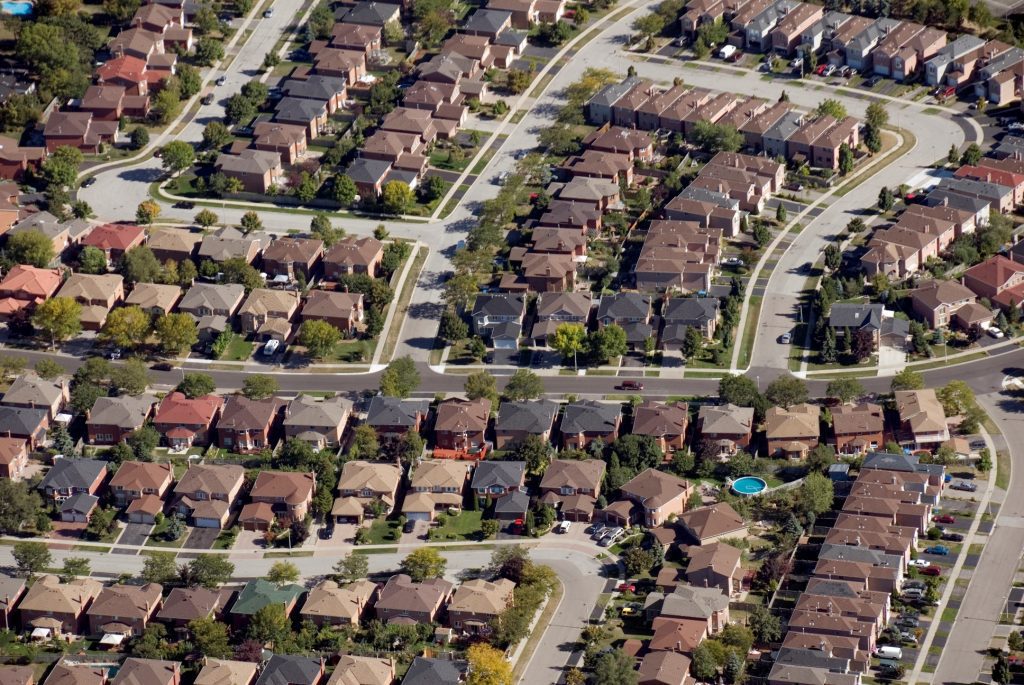Statement by Phil Pothen, Ontario Environmental Program Manager, Environmental Defence
Toronto | Traditional territories of the Huron-Wendat, the Anishnaabeg, Haudenosaunee, Chippewas and the Mississaugas of the Credit First Nation – By forcing passage of Bill 23, the “More Homes, Built Faster Act”, Ontario’s government has lit the fuse on an explosion of expensive sprawl that will destroy much of the remaining wetland and wildlife habitat in Ontario’s most sensitive ecoregions.
Moreover, while the Ontario government has attempted to defend Bill 23’s dismantling of flood and habitat protection, regional planning and green building standards by framing it as a measure to address the province’s housing shortage and lack of affordability, it is likely to have the opposite effect. The legislation is likely to result in fewer and more expensive homes, higher costs of services, less energy efficient construction, increased car dependency and transportation expenses for residents, and increased property taxes.
Bill 23 must be repealed.
Rejecting warnings from virtually all non-partisan science experts and municipal governments of all stripes, the government has refused to remove Bill 23’s most central and dangerous feature: an attack on Conservation Authorities’ flood prevention and land protection roles that will enable wholesale destruction of wetland habitats and conservation lands – and expose us all to an escalating risk of floods and other disasters.
Bill 23 has stripped Conservation Authorities of the power to refuse permission for sprawl or other land development that their experts know would cause flooding and erosion or destroy wetlands and other conservation lands. It goes still further, by prohibiting Conservation Authorities from agreeing to provide municipalities with the information and expertise they would need to have any hope of filling the gap in protection themselves.
Bill 23 is likely to make it harder to tackle either the province’s housing shortage or high housing prices because the cumulative effect of its measures will be to divert scarce skilled construction labour and materials away from adding compact homes (especially family homes) to existing neighborhoods. The Bill:
- waters down or omits entirely required zoning reforms, leaving in place so many barriers to creation of new “missing middle” homes in the existing low-rise neighborhoods where they are most desperately needed, that the government’s own documents admit only 50,000 of a total 1.5 million homes would be created there, province-wide
- eliminates the coordinated regional planning that is required to promote efficient use of construction resources and lands, causing a great deal of housing construction, and the vast bulk of residential land, to be squandered on the most expensive and resource-intensive forms in areas far from jobs, schools and services
- pushes newcomers – and new households – into car-dependent and disconnected places where they don’t want to live, while making it harder for municipalities to retrofit existing car-dependent subdivision to be lower-cost and lower-emissions places to live.
- destroys many of the existing “green” building standards that municipalities use to make new homes that are cheaper for tenants or purchasers to heat and cool – and which are vital to reducing greenhouse gas emissions.
The simultaneous climate, biodiversity and housing crises demand that we preserve every acre of farmland and habitat, and wisely use scarce construction materials, construction labour, equipment and supporting infrastructure to maximize the construction of well-designed, low-cost homes. Only this approach can transform existing low-density, car-dependent, over-taxed towns and cities into communities where people can afford to live, move quickly and cheaply by public transit, foot and bicycle and have access to work, school, shopping and recreation.
Bill 23 drags Ontario forcefully and dramatically in the wrong direction, disregarding the advice of its own Task Force, along with all the hard-won lessons of the last 70 years, in favour of a return to the expensive low-density and car-dependent sprawl which is the root cause of our current housing and environmental crises. This dangerous Bill has been forced into law through a process designed to prevent meaningful consideration of its impacts, discussion with those affected, or on a time frame that reflects the enormity of the changes. We will all need to work together to see this legislation repealed.
ABOUT ENVIRONMENTAL DEFENCE (environmentaldefence.ca): Environmental Defence is a leading Canadian environmental advocacy organization that works with government, industry and individuals to defend clean water, a safe climate and healthy communities.
– 30 –
For more information or to request an interview, please contact:
Allen Braude, Environmental Defence, abraude@environmentaldefence.ca, 416-356-2587
Backgrounder: A Schedule by Schedule Analysis of the Biggest Environmental Impacts of Bill 23
SCHEDULE 1: CITY OF TORONTO ACT, 2006
Jeopardizing Rental Replacement
The amendment to s. 111 of the City of Toronto Act would empower the Minister of Municipal Affairs and Housing to unilaterally limit the City of Toronto’s much-lauded rental replacement policy.
The Rental Replacement Policy ensures that when rental apartments are demolished to make way for new development, the tenants are entitled to a replacement unit of roughly the same size and type in the new development, at the same rent as before – as well as temporary accommodation at the interim.
In the absence of the Rental Replacement Policy, construction of much-needed new housing will frequently result in the displacement of existing tenants who currently pay lower rents, and will require them to enter new leases at rents that will almost always be much higher.
Killing the Toronto Green Standard?
The amendment to s. 114(6) of the City of Toronto Act, and the addition of to s. 114 (1.2) would remove the statutory authority for many parts of the Toronto Green Standard, and narrow its application considerably – potentially making it impossible for the City of Toronto to meet its building emissions targets.
It is not clear that government-supported amendments to Bill 23 are actually effective in addressing this problem.
SCHEDULE 2: CONSERVATION AUTHORITIES ACT
Facilitating a Mass Sell-Off of Conservation Lands
When land is owned by conservation authorities, Ontarians trust that it will remain permanently off-limits for destruction. Outside of extraordinary circumstances, in which case there is direct approval from the Minister or a provincial agency, board or commission, Authorities are not permitted to sell off conservation lands for development. Bill 23 would remove the requirement for government permission, and allow the sale of conservation lands – including endangered or threatened species habitat, wetlands, and areas of natural and scientific interest. Where a sale is for “provincial or municipal infrastructure and municipal purposes,” the authority is not even required to consult on these dispositions.
Open Season for Sprawl on Wetlands
Many of Ontario’s rarest and most at-risk wildlife and habitats are concentrated in the same “crisis ecoregions” which the vast majority of the province’s people live, and where pressure for suburban residential, commercial and residential sprawl is most intense
This Bill would remove the power of Conservation Authorities to regulate or prohibit sprawl developers and land speculators from destroying wetlands, river or stream valleys, within their jurisdiction, in almost every case. It does this through Section 7 of the Bill, which would amend s. 28 of the Conservation Authorities Act to exempt any project that has received land use planning approval under the Planning Act from Conservation Authority regulations regulating water-taking, interference with rivers, creeks, streams, watercourses, and wetlands, or controlling flooding, erosion, conservation of land.
Sections 8. (3)(a), 8(6)(a), 9 (1) (a), 9 (2) (a) & (b), 10 (4) (a), 10 (7)(a), 11(2)(1), 12 (2)(i) of the Act would remove the power of Conservation Authorities to protect the ecological function and potentially the long-term stability and viability of wetlands. It would do this by removing the power to regulate – and refuse permits based on “pollution or the conservation of land”, and removing the obligation of the minister to consider those matters in appeals.
Gagging Conservation Authorities
Bill 23 doesn’t just prohibit Conservation Authorities from protecting conservation lands, wetlands, river or stream valleys themselves, amendments to s. 21.1.1 and s. 21.1.2 of the Conservation Authorities Act actually goes so far as to “gag” them – prohibiting them from providing Municipalities with the information they need in order to start protecting conservation lands themselves when they consider land use planning approvals.
If the Bill passes, Conservation authorities will not be allowed to” provide under subsection (1), within its area of jurisdiction, a municipal program or service related to reviewing and commenting on a proposal, application or other matter made under a prescribed Act.”
The result will be a massive gap in Ontario’s system for protecting public safety and ecosystems, and ultimately, the unleashing of bulldozers and backhoes on cumulatively vast areas of wetland, forest and other sensitive areas currently off-limits for development.
SCHEDULE 3: DEVELOPMENT CHARGES ACT, 1997
Bill 23 would seem to jeopardize the ability of municipalities to use development charges-as intended – to gather funds for large infrastructure projects to accommodate and support growth. It would do this by requiring municipalities to spend or allocate 60 per cent of reserve funds each year.
SCHEDULE 4: MUNICIPAL ACT, 2001
Opening the Door to Displacement of Lower-Income Tenants
Just as Schedule 1’s amendments to the City of Toronto Act, attack rental replacement policies in Toronto, Schedule 4 amendments to the Municipal Act, 2001 would empower the Minister of Municipal Affairs and Housing to unilaterally limit – and even dismantle rental replacement policies of other Ontario municipalities,
As mentioned above, these policies ensure that when rental apartments are demolished to make way for new development, the tenants are entitled to a replacement unit of roughly the same size and type in the new development, at the same rent as before – as well as temporary accommodation at the interim.
In the absence of the rental replacement policies, construction of much-needed new housing will frequently result in the displacement of existing tenants who currently pay lower rents, and will require them to enter new leases at rents that will almost always be much higher.
SCHEDULE 9: PLANNING ACT
Contrary to the government’s messaging, the main thrust of its amendments to the Planning Act – and the main thrust Bill 23 overall – is to legalize and provoke a massive acceleration of suburban sprawl into wetlands, forests, farmland, and other areas on the rural outskirts of major population centers in Ontario’s most sensitive ecoregions.
Unilaterally Imposing Sprawl on Municipalities that Choose Smart Growth
Over the past year, Ontario municipalities like Hamilton, Halton and and Waterloo have made extraordinary strides in protecting wildlife habitat and farmland and delivering the denser, walkable, lower-cost forms of housing in existing neighborhoods, by adopting ground-breaking plans that would allocate all – or almost all – of their new homes and workplaces to existing neighborhoods, built up areas, and their existing supply of unused designated greenfield area.
One of the most glaring features of this Bill’s amendments to the Planning Act is the removal of the last procedural obstacles to the Minister unilaterally imposing sprawl on those conscientious municipal governments. Recent legislation allowed the provincial government to amend these plans, but only if there was an adverse affect on provincial interests protected by the Provincial Policy Statement, and only after the municipality was given the opportunity to remedy any non-compliance.
This Bill’s amendments to the s. 23 of the Planning Act would allow the government to directly impose sprawl on those municipalities, without any opportunity to accommodate demand for housing and workplaces in their own way.
Destroying Regional Planning in the Greater Golden Horseshoe
Even more concerning is the Bill’s proposal to entirely eliminate coordinated regional planning in Ontario’s Golden Horseshoe. In Simcoe, Durham, Halton, Peel, Niagara and Waterloo and York Region, regional planning is meant to prevent “patchwork” sprawl that wastes construction resources and infrastructure, to enable regional governments to ensure that development can be serviced effectively, and to ensure that land isn’t wasted.
The Bill would remove the power of regional governments to plan where new homes and workplaces go, and the densities at which they are built, to prevent the squandering of farmland and wildlife to habitat – and to ensure that new and existing communities can be serviced with public transit, water and other infrastructure.
The effect of Bill 23 will be a region-wide race to the bottom when it comes to land-use planning, with lower-tier municipalities that lack experienced land use planning staff pressured to expand settlement boundaries onto vital farmland and habitat, or into places where they can never be serviced effectively.
Failure to Deliver on Densification: Exiling Families to Sprawl
All of Ontario’s major municipalities are on a race against time to bring post-WWII neighborhoods, in particular, up to densities that support frequent, reliable public transit, and allow most residents to get by comfortably without a car. That is in part because of the need to both to make room for everyone who wants to live there – and to stop pushing residents into sprawl. It is also because reducing car trips is vital to meeting Ontario’s obligations to eliminate greenhouse gas emissions before it is too late. However, it is also because the population growth that enables us to deliver them without massive hardship will not continue forever. Ontario cannot afford to squander homes and workplaces that are needed to fix existing sprawl right now on the creation of even more sprawl suburbs in wetlands and farms.
Unfortunately, Bill 23 fails to deliver the changes required to meet demand for housing in existing neighborhoods. Measures to require that zoning be updated to facilitate densification around public transit are a modest step in the right direction. However, Planning Act amendments hyped as meeting demand for family homes in low-traffic residential neighborhoods are nowhere near what is required to deliver meet demand for that kind of housing – particularly in Toronto, where vast numbers of family homes must be created within the next 30 years. Promised reforms to remove or reduce exclusionary “single detached” zoning, were watered down to such a degree that, according to the government’s own documents, they would create just 50,000 of the 1,500,000 promised homes. Contrary to government messaging, amendments to s. 16(3) of the Planning Act do not allow modest, purpose-built walk-up apartments or even townhomes to be built as of right on the existing lots currently being squandered on single detached McMansions. It is difficult to see how the changes permitted by the Bill – which allows up to two additional residential units within a detached house, semi-detached house or rowhouse, or in a modest ancillary structure, go meaningfully beyond what is already permitted in the City of Toronto.
SCHEDULE 10: SUPPORTING GROWTH AND HOUSING IN YORK AND DURHAM REGIONS ACT, 2022
Unleashing Sprawl in York Region and Northern Durham Region
While municipalities like Hamilton and Waterloo made an unprecedented effort to deliver housing in affordable and environmentally sustainable way, York Region, in particular, allowed itself to strong-armed by the provincial government into defying existing land use planning rules by submitting boundary expansion requests that would mark far more farmland and wildlife habitat for destruction than could ever plausibly be required to meet housing need. Moreover, York Region approved boundary expansion on large swathes of land – in the overtaxed Lake Simcoe watershed that lacked any capacity at all for further expansion.
The new “Supporting Growth and Housing in York and Durham Regions Act, 2022, which would be created by Bill 23, aims to facilitate York Region’s reckless and excessive boundary expansion by forcing a massive sewage tunnel through the Greenbelt and the sensitive Oak Ridges Moraine. This law would exempt the project from many features of Environmental Assessment, and even from the Environmental Bill of Rights.





